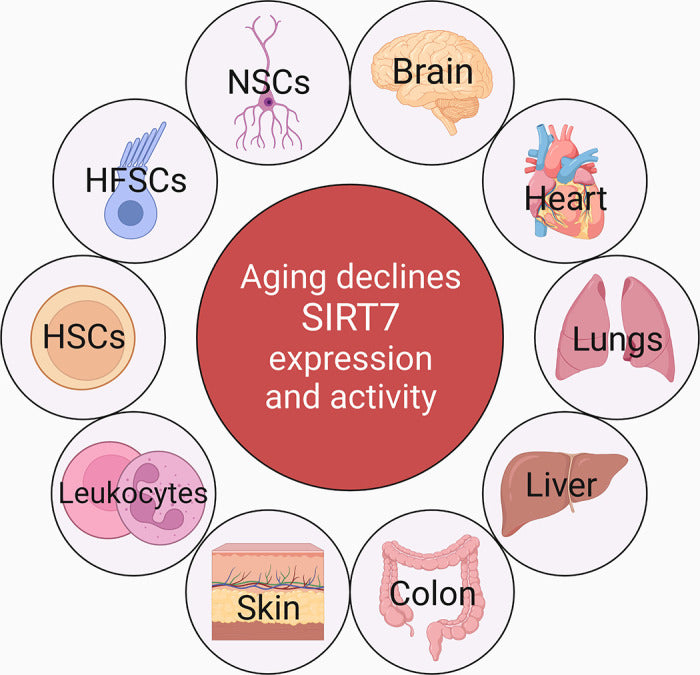
SIRT7 in Stem Cell Aging and Health
As we navigate the complexities of aging, the quest for longevity and vitality remains a top priority for researchers and health enthusiasts alike. Recent studies have shed light on the role of a specific protein, SIRT7, in regulating stem cell aging and its potential implications for health, regenerative medicine, and beauty. This article explores the mechanisms by which SIRT7 influences stem cell function, its impact on aging, and the broader health benefits associated with its activity.
Understanding SIRT7 and Its Function
SIRT7 is part of the sirtuin family, a group of proteins that play critical roles in cellular regulation, metabolism, and aging. Sirtuins are known for their ability to sense nutritional status and stress, thus influencing various biological processes. SIRT7, in particular, has garnered attention for its involvement in mitochondrial function, gene expression, and stem cell maintenance.
The Connection Between SIRT7 and Stem Cells
Stem cells are essential for tissue regeneration and repair, possessing the unique ability to differentiate into various cell types. However, as organisms age, the functionality of stem cells declines, leading to reduced regenerative capacity and increased susceptibility to diseases. Research indicates that SIRT7 plays a key role in maintaining the health and functionality of hematopoietic stem cells (HSCs) in the bone marrow.
1. Metabolic Regulation: SIRT7 regulates mitochondrial function, which is crucial for energy production in stem cells. Healthy mitochondria are necessary for the maintenance of stem cell quiescence and proliferation.
2. Nutrient Sensing: SIRT7 is involved in the body’s response to nutrient availability. During nutrient deprivation, SIRT7 levels increase, promoting cellular survival and adaptation. This mechanism helps stem cells resist stress and maintain their function.
3. Gene Expression: By interacting with key transcription factors, SIRT7 modulates gene expression patterns that are vital for stem cell identity and function. This regulation is essential for preventing premature aging of stem cells.
Health Benefits of Activating SIRT7
1. Anti-Aging Effects
Research suggests that enhancing SIRT7 activity may help combat the aging process at the cellular level. By preserving stem cell functionality and promoting healthy mitochondrial activity, SIRT7 could potentially slow down the aging of various tissues, thereby extending lifespan and improving overall health.
2. Regenerative Medicine Applications
The insights gained from studying SIRT7 can pave the way for innovative therapies in regenerative medicine. By restoring or enhancing SIRT7 function in aging or damaged stem cells, researchers may develop treatments that promote tissue regeneration and repair, benefiting conditions such as:
- Bone Marrow Disorders: Enhancing HSC function could improve outcomes for patients with blood-related disorders.
- Muscle Regeneration: Similar mechanisms in muscle stem cells may help reverse age-related decline in muscle mass and function.
3. Beauty and Skin Health
The principles of stem cell rejuvenation extend to the beauty industry. By harnessing the regenerative potential of stem cells and the protective effects of SIRT7, cosmetic formulations could be developed to promote healthier, more youthful skin. Ingredients targeting SIRT7 activity may help improve skin elasticity, reduce wrinkles, and enhance overall complexion.
Future Directions in SIRT7 Research
The exploration of SIRT7’s role in aging and stem cell function is still in its early stages, but the findings thus far are promising. Future research could focus on:
- Pharmacological Approaches: Investigating compounds that can enhance SIRT7 activity as potential therapeutic agents for age-related conditions.
- Diet and Lifestyle Interventions: Understanding how dietary choices and lifestyle factors influence SIRT7 expression and activity, which could lead to practical recommendations for enhancing longevity.
Conclusion
The discovery of SIRT7's role in stem cell aging offers exciting possibilities for promoting health and longevity. By understanding and harnessing the mechanisms that underlie stem cell function, we can work toward innovative strategies that not only extend lifespan but also enhance the quality of life. As research continues to unfold, the implications of SIRT7 could revolutionize approaches to aging, regenerative medicine, and beauty.
Embracing advancements in scientific research will empower us to take proactive steps toward a healthier, longer life.
Sources:
1. National Institutes of Health - Aging and Longevity Link
2. Harvard Health Publishing - The Role of Stem Cells in Aging Link
3. Mayo Clinic - Regenerative Medicine Link